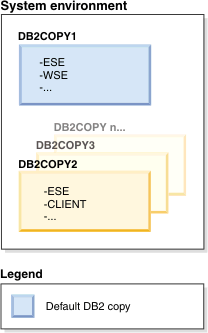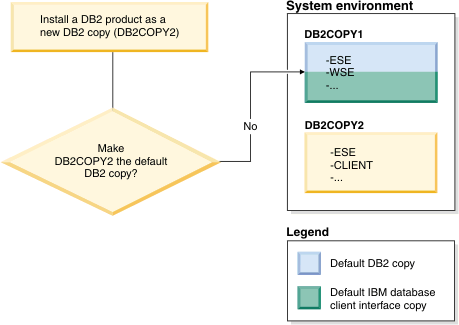Installing DB2 Servers > Installing on Windows >
Multiple DB2 copies on
the same computer (Windows)
You can use multiple DB2® copies
on the same computer. Each DB2 copy
can be at the same or different code levels. The benefits of doing
this include:
- The ability to run applications that require different DB2 versions on the same machine
at the same time.
- The ability to run independent copies of DB2 products for different functions.
- The ability to test on the same computer before moving the production
database to the latter version of the DB2 product.
- For independent software vendors, the ability to embed a DB2 server product into your product
and hide the DB2 database from
your users.
A DB2 copy can contain one
or more different DB2 products.
This refers to the group of DB2 products
that are installed at the same location.
Differences when only one DB2 copy
is installed
- During installation, a unique Default DB2 copy name is generated. You can only change
the name of the default DB2 copy
as you go through the DB2 Setup
wizard. You cannot change the DB2 copy
name after the installation is completed.
- Applications use the Default DB2 copy
in an environment similar to the DB2 Version
8 environment.
Differences when multiple DB2 copies
are installed on the same computer
- DB2 Version 8 can coexist
with DB2 Version 9.1 and DB2 Version 9.5, with restrictions
described below.
- The DB2 Version 8 copy must
be the default copy even though you may have multiple copies of DB2 Version 9.1 or Version 9.5.
This default copy cannot be changed. After DB2 Version 8 is uninstalled, you can use the
Global Switcher to set the default copy to any the DB2 Version 9.1 or Version 9.5 copies.
- Optional: You can configure each DB2 copy
to use a different DB2 Information
Center.
Note:
You can have only one copy of the DB2 Information Center installed on the same
system at the same Release level. Specifically, you can have a Version
8, a Version 9.1, and a Version 9.5 (or higher) DB2 Information Center on the same
system, but you cannot have one DB2 Information
Center at Version 9 fix pack 1 and another at Version 9 fix pack 2
on the same machine. You can however configure the DB2 database server to access these DB2 Information Centers remotely.
- Only the IBM® Data Server
Provider for .NET from the default IBM database
client interface copy is registered in the Global Assembly Cache.
If Version 8 is installed with Version 9, the IBM Data Server Provider for .NET 2.0 Provider
from Version 9 is also registered in the Global Assembly Cache. Version
8 does not have a 2.0 .NET provider.
- Each instance name must be unique. For a response file installation
with NO_CONFIG=YES, the default instance will not be created. However,
when you create the instance after the installation, it must be unique.
The name of the default instance will be "DB2". If an instance of the "DB2" name already exists, a unique name for
the instance is generated to ensure uniqueness. This is done by using
the "DB2" name and adding
an underscore and generating the last 2 characters in numerical sequence.
The subsequent instance names generated are "DB2_01", "DB2_02",
and so on. For performance reasons, the DB2 Control
Center should only be used from one DB2 copy
at a single time on a machine.
For Microsoft® COM+
applications, it is recommended that you use and distribute the IBM Data
Server Driver Package (installer) or IBM Data Server Driver for ODBC and CLI (zip) with
your application instead of the IBM Data Server Runtime Client as
only one Data Server Runtime Client can
be used for COM+ applications at a time. The IBM Data
Server Driver Package (installer) or IBM Data Server Driver for ODBC and CLI (zip) does
not have this restriction. Microsoft COM+
applications accessing DB2 data
sources are only supported with the default DB2 copy. Concurrent support of COM+ applications
accessing different DB2 copies
is not supported. If you have DB2 Universal
Database (UDB) Version 8 installed, you can only use DB2 UDB Version 8 to run these applications.
If you have DB2 Version 9 or
higher installed, you can change the default DB2 copy using the Default DB2 Copy Selection Wizard, but you can not use
them concurrently.
Choosing a default when installing a new DB2 copy
In Version 9.1, you can have a scenario where you have installed
multiple DB2 copies. (In this
example, DB2COPY1, DB2COPY2, and on to DB2COPYn.) One of the DB2 copies is selected by you as
the default DB2 copy. In this
case, DB2COPY1 is selected as the default DB2 copy.
Beginning with Version 9.5, image a scenario where you install
one DB2 copy (DB2COPY1). It
is the default DB2 copy and
the default IBM database client
interface copy.
Then you install a DB2 product in a new DB2 copy (DB2COPY2). During the installation
of the new DB2 copy (DB2COPY2)
you are asked if you want to make the new DB2 copy the default DB2 copy. If you respond "No", then DB2COPY1
remains the default DB2 copy.
(It is also the default IBM database
client interface copy.)
However, consider the same scenario but you respond "Yes" when
asked if you want to make the new DB2 copy
the default DB2 copy.
In this case, DB2COPY2 becomes the new default DB2 copy (and the default IBM database client interface copy).
- Version 8 coexistence
- DB2 Version 8 and DB2 Version 9 can coexist with the
restriction that DB2 Version
8 is set as the Default DB2 copy.
To no longer have DB2 Version
8 as the Default DB2 copy, you
can upgrade that DB2 copy to DB2 Version 9 and then change the
Default DB2 copy.
On the server,
there can be only one DAS version and it administers instances as
follows:
- If the DAS is on Version 9, then it can administer Version 8 and
Version 9 instances.
- If the DAS is on Version 8, then it can administer only Version
8 instances. You can upgrade your Version 8 DAS, or drop it and create
a new Version 9 DAS to administer the Version 8 and Version 9 instances.
This is required only if you want to use the Control Center to administer
the instances.
- Version 8 and Version 9 coexistence and the DB2 .NET Data Provider
- In DB2 Version 9, the DB2 .NET Data Provider has System.Transaction
support. However, this is only available for the default DB2 copy and is therefore not supported in a
coexistence environment. If Version 8 is installed, the 1.1 .NET Data
Provider registered in the Global Assembly Cache will be from Version
8. The 2.0 provider, that is registered, will be from Version 9. The
2.0 provider cannot be used in the same process that uses the 1.1
provider, OLE DB, or ODBC to connect to DB2.
- 3rd party applications that run as a service
- By default, 3rd party applications that dynamically bind DB2 DLLs, for example, that are
linked with db2api.lib, will find the DB2 DLLs
in the current PATH. This means that existing applications that are
not enabled for multi-version support will use the Default DB2 copy. To work around this, the
application can use the db2SelectDB2Copy API before loading any DB2 libraries. For more information,
see the Call
Level Interface Guide and Reference, Volume 1.
- 32- and 64-bit versions on Win x64
- DB2 does not support multiple DB2 32- and 64-bit versions installed
on Windows®. If you install
the DB2 64-bit version, the
32-bit version will be removed from the system. This is because the DB2 32- and 64-bit registries reside
in different locations.
- LDAP and CLI configuration
- With DB2 Version 8, if an
application needs different LDAP settings, it needs to use a different
LDAP user. Otherwise, the CLI configuration will affect all DB2 copies that the LDAP user might
potentially use.
- Performance counters
- Performance counters can be registered for only one DB2 copy at a time and they can monitor only
the instances in the DB2 copy
in which they are registered. When you switch the Default DB2 copy, the DB2 Selection Wizard de-registers and reregisters
the performance counters so that they are active for the Default DB2 copy.
- Windows Management Instrumentation
(WMI)
- Only one version of the WMI provider can be registered at any
given time.
- Client Connectivity
- You can use only one DB2 copy
in the same process.
- Applications that dynamically link DB2 DLLs
- Applications that link to DB2 DLLs
directly or that use LoadLibrary instead of LoadLibraryEx with the
LOAD_WITH_ALTERED_SEARCH_PATH parameter will need to ensure that the
initial dependent library is loaded properly. You can use your own
coding technique to do this, or you can call the db2envar.bat file
to setup the environment before running the application, or you can
call the db2SelectDB2Copy API, which can be statically
linked into the application.
Visual Studio 2003 plugins
If the default DB2 copy
is a Version 9.5, a Version 9.1, or a Version 8 copy, there can
be only one version of the plugins registered on the same computer
at the same time. The version of the plugins that is active will be
the version that is shipped with the default DB2 copy.
Licensing
Licenses need to be registered for each DB2 copy. They are not system-wide. This allows
different licenses for different paths and provides the ability for
both restricted versions of DB2 copies
of the product and full versions of DB2 copies
on the same machine.
NT Services
DB2 NT services will use
the <servicename_installationname>. For example, DB2NETSECSERVER_MYCOPY1.
The display name also contains the Copy Name appended to it in brackets,
for example, DB2 Security Server
(MYCOPY1). Instances also include the DB2-<DB2 Copy Name>-<Instance
Name>-<Node Number> in the display name, which is shown in the
services control panel applet. The actual service name remains as
is.
API to select the DB2 copy
to use
You can use the db2SelectDB2Copy API to select
the DB2 copy that you want your
application to use. This API does not require any DLLs. It is statically
linked into your application. You can delay the loading of DB2 libraries and call this API
first before calling any other DB2 APIs.
Note that the function cannot be called more than once for any given
process; that is, you cannot switch a process from one DB2 copy to another.
The db2SelectDB2Copy API sets the environment
required by your application to use the DB2 copy
name or the location specified. If your environment is already set
up for the copy of DB2 that
you want to use, then you do not need to call this API. If, however,
you need to use a different DB2 copy,
you must call this API before loading any DB2 DLLs within your process. This call can be
made only once per process.
Database Partitioning with multiple physical nodes
Each physical partition must use the same DB2 copy name on all computers.
Using MSCS and Multiple DB2 Copies
Each DB2 resource must be
configured to run in a separate resource monitor.
[ Top of Page | Previous Page | Next Page | Contents ]


